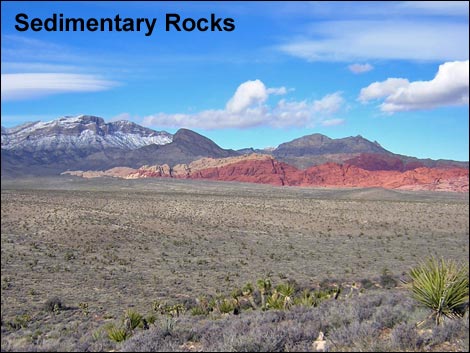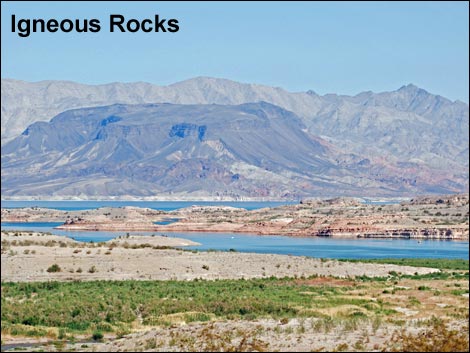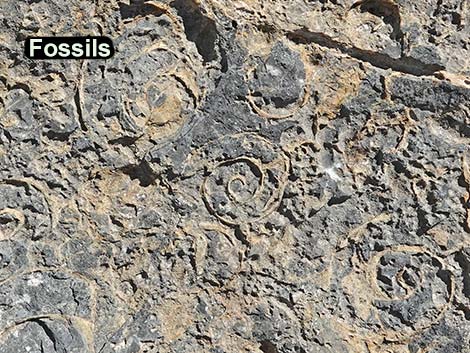

Rocks and Geology Around Las Vegas is intended to give a hiker's-level overview of the mountains and rocks around Las Vegas, giving hikers and botanists enough information to recognize the main types of rocks and basic information on how they formed. Most people look at rocks as unchanging, something that always has been and always will be. The rocks we see today, however, are part of a process where the landscape changes over time, and when we understand rocks as a process, our appreciation of the world around us -- how it got that way and how we fit with it -- is so much greater.
There are only three basic types of rock: Sedimentary, Volcanic, and Metamorphic.
 Red Rock Canyon: red and white sandstone and gray limestone |
Sedimentary Rocks, the most common rocks around Las Vegas, are formed by one of two processes. First, sedimentary rocks may be formed by cementing together particles that eroded from pre-existing rocks. Particles are washed or blown away to accumulate somewhere else, and if left in place long enough, can become cemented to form rocks such as conglomerate, fanglomerate, sandstone, and mudstone, depending on the size of the particles and the degree of sorting of the eroded materials. Second, sedimentary rocks may form on the bottom of the ocean when particles "rain" down from the surface. These particles can become compressed and cemented to form limestone. Fossilized sea creatures sometimes are found in these rocks. Most of the mountains around Las Vegas are composed of sedimentary rocks. Red Rock Canyon (photo at left) provides spectacular examples of both types: the gray mountains are limestone, and the red-and-white crags are sandstone. |
 Lake Mead: flat-topped Fortification Hill |
Igneous Rocks, less common around Las Vegas, are formed when magma (hot, molten material from deep within the earth) cools. When magma pours out of a volcano and cools at the surface, it typically forms lava. When magma explodes out of a volcano, it can form fragmented (pyroclastic) rock, ash-flow tuffs, and volcanic glass (obsidian). When magma cools slowly deep underground, it forms granite. Fortification Hill (photo) on the east side of Lake Mead provides a spectacular view of igneous rocks. The black hill is lava from an ancient volcano (background), the top of which eroded away to reveal the light-colored granitic core. Out at Lake Mead, the dark-colored mountains along the Colorado River are volcanic. Granite is uncommon in southern Nevada, but occurs out in the Gold Butte Region (north of Lake Mead along the Nevada-Arizona border). |
 South McCullough Mountains |
Metamorphic Rocks, common to uncommon around Las Vegas depending on the type, are formed by altering the structure of pre-existing rock. This usually results from high pressure and temperatures deep within the crust of earth, but rocks can be chemically altered. Metamorphic rocks are never melted in the process, just heated and squeezed such that the minerals in the original rock are changed. The type of metamorphic rock that results from the heat-pressure process depends on the original rock and the degree and type of alteration. For example, sandstone changes to quartzite, clay-rich sedimentary rocks change to schist, and granite changes to gneiss. Limestone is chemically changed to dolomite when some of the calcium carbonate is replaced with magnesium carbonate. Typical (heat-pressure) metamorphic rocks are uncommon in this area, but look for them in the South McCullough Wilderness Area and northern Gold Butte. Chemical metamorphic rocks are quite common in this area, as much of the gray-colored "limestone" in the mountains around Las Vegas are actually dolomite, but it is nearly impossible to tell just by looking. |
 Snail shells in limestone: Desert National Wildlife Range |
Fossils. Fossils are a record of the history of life on Earth captured in stone. The breadth of time recorded in the rocks around Las Vegas spans about half of the history of the Earth, and almost the entire fossil record is recorded here. Invertebrate fossils (e.g., corals, bivalves, crinoids, and sponges) are common in the sedimentary rocks that make up the mountains around Las Vegas, and trilobites and gastropods can be found in a few places. Tracks of dinosaurs are recorded in the Red Rock cliffs, at Gold Butte, and at Valley of Fire, and the tracks of extinct birds and mammals can be seen at Lake Mead National Recreation Area. Even the bones of extinct mammals can be found here. Petrified wood is common at Valley of Fire and can also be found at Red Rock Canyon National Conservation Area. Tule Springs National Monument was set aside to protect Ice Age fossils, mostly mammals. Link to some fossil collecting sites: Cadiz, Chambless, Nopah, Oak Springs, Frenchman Mountain. |
Note: All distances, elevations, and other facts are approximate.
![]() ; Last updated 240331
; Last updated 240331
| Hiking Around Las Vegas | What's New? | Guide Services | Glossary | Copyright, Conditions, Disclaimer | Support this website! |